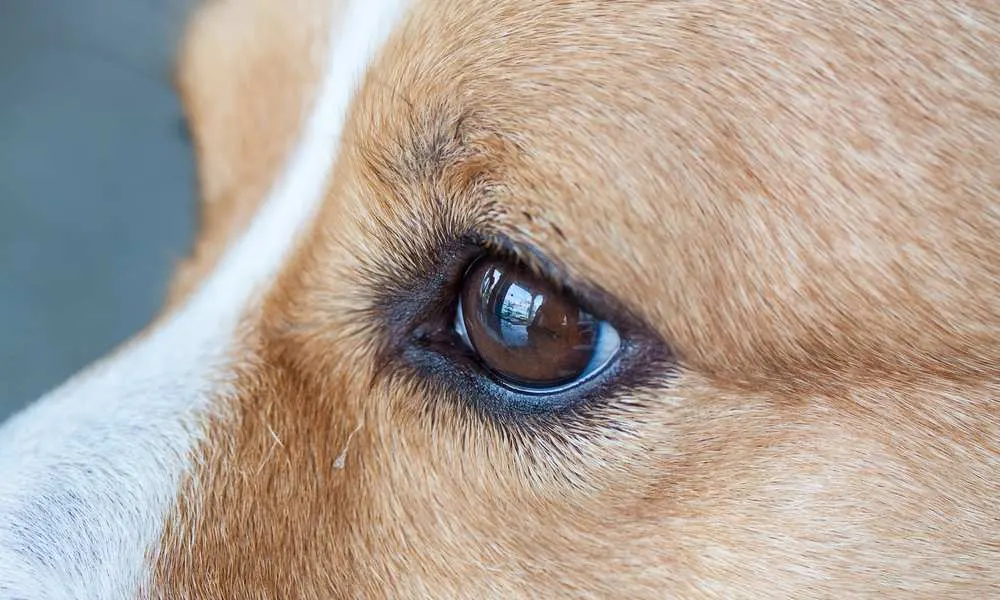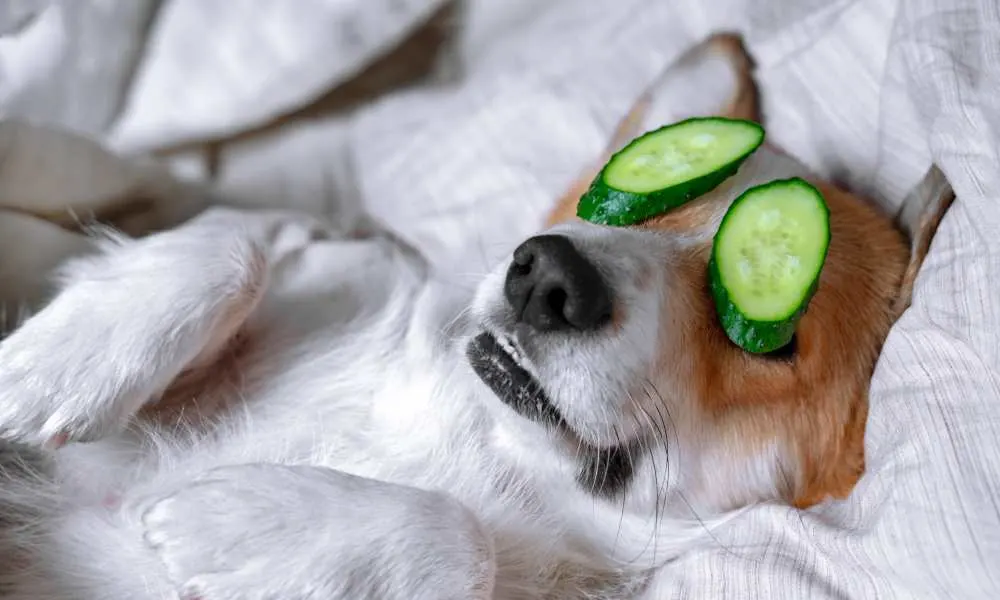How familiar are you with dog tear stains? If you are interested in finding out more about whether your corgi can develop tear stains, scroll down and find out.
Many dog breeds deal with eye problems throughout their lifespan, and some of them leave them with visible consequences. If you are wondering:
Do corgis get tear stains?
The answer is YES. This is a condition that can occur in many dog breeds, and your pet corgi is one of them. Tear stains are the aftermath of something else that has been going on with your corgi. So if you are interested in what provokes tear stains and ways in which you can prevent them, we have got it all covered.

Corgi Tear Stains – Causes: Do Corgis Have Watery Eyes?
Some dog breeds develop severe eye problems, and a majority of them start with “having a dry eye”. This will interfere with your dog’s daily activities, and he will try to “fix” it by scratching.
On the other hand, some breeds give the impression that they have been crying all day. Watery eyes are also a result of some irritation that has been bothering your pup.
Do corgis have watery eyes?
Yes, they do. If you have noticed that your corgi’s eyes are itchy and that it has small dark circles under his eyelids, you are looking at tear stains. Yes, corgis get tear stains.
What are they exactly, and how do they occur?
Tear stains are those small circles that appear under your dog’s lower eyelids. They are a visible result of a number of different eye conditions. Tear stains occur if you have been ignoring your corgi’s watery eyes.
Tear stains can be connected to a lot of different things, and not all of them are good.
The list of tear stain triggers is pretty long. Here are the most common eye problems that lead to dog tear stains:
TEAR STAIN TRIGGERS IN CORGI DOGS
| EPIPHORA: | The simplest way to describe epiphora in dogs is excessive tearing. It is often the result of an infection in the eyelid. Epiphora can also cause some minor bleeding. Nevertheless, visiting the vet is a must. |
| ENTROPION: | Entropion is when the eyelashes irritate the eyelid. Although it is not that common for the corgi breed, it is still a possibility, and it can cause excessive tearing and redness. |
| DISTICHIASIS: | Distichiasis is similar to the already mentioned entropion, and it has to do with the eyelashes growing in the wrong way. This can be taken care of with minor surgery.. |
| GLAUCOMA: | Glaucoma is a fluid buildup in the eyelids which results in huge tear stains. This buildup can also damage the optic nerve. |
| CONJUCTIVITIS: | Just like humans, corgis can suffer from conjunctivitis and get tear stains as a result. This is a disease that is caused by frequent irritation of the eyelid. |
| TEETHING: | Teething can be a very painful experience for your corgi puppy, and excessive tearing can leave him with tear stains at a very early age. |
| EAR INFECTIONS: | Ear infections are very tricky. These internal problems can affect other organs. In this case, it can cause eye inflammation. |
| SCARS: | If your corgi has been injured and you haven’t healed the wound properly, this can result in itching and excessive tearing. |
| ALLERGIES: | If your corgi is allergic to something, it’s tearing up might represent a response, and this can cause tear stains to show up. |
| CATARACTS: | Cataracts are a common eye problem with corgi dogs. This causes sight problems, and the color pupils will probably change. Cataracts can cause your dog to blink and tear up more frequently. |
CAUTION: Although eye infections are the most common cause of corgi tear stains, it is also important to note that you, as their owner, can also contribute to this condition. And how do you do that?
Easy. You can act as a secondary influence, and the things you do have the most effect:
- The smoke from cigarettes,
- Spending time in a polluted environment,
- Not washing your dog’s ears
- Not cleaning your dog’s bed
So, the blame isn’t always on the health predispositions of your corgi. Sometimes, it is on you too.
Learn More: How To Clean Corgi Ears?

Corgi Tear Stains – Prevention
Tear stains might be a common problem, but the good thing is that you can prevent and cure them. The most efficient solutions for dog tear stains are:
- Improving food and water quality
- Daily hygiene
- Avoiding moist and rusty areas
- Regular grooming
- Buying tear stain removers
Let’s get to explaining.
1. IMPROVING FOOD AND WATER QUALITY
Some of the most common diseases and infections come from what we use everyday – food and water. Poor quality food and contaminated water can significantly affect your dog’s health. This is precisely what can cause tear stains in dogs.
Some people even recommend adding certain additives like organic apple vinegar, buttermilk powder to your corgi’s diet. Make sure that you provide your corgi with good quality dog food and that the water he drinks is 100% clean – you will avoid many problems.
2. DAILY HYGIENE
Maintaining hygiene is undoubtedly very important for a dog’s health. Regular washing of the ears and eyes will prevent your dog from getting tear stains. Of course, when we say to wash the ears and eyes, we mean to do it in detail. Otherwise, it has zero effect.
3. AVOIDING MOIST AND RUSTY AREAS
Moist and rusty areas around the household can cause irritation with your dog’s eyes. Being regularly exposed to moisture can cause infection in the dog’s ears, around the muzzle, and eyelids. Be aware of the environment you are bringing your corgi into.
4. REGULAR GROOMING
You should dedicate yourself to regular grooming of your dog’s coat, especially if that dog is a corgi. Their double coat of your corgi sheds multiple times during the year. The excessive hairs from your corgi’s coat can be the source of numerous infections.
5. BUYING TEAR STAIN REMOVERS
Today, owners are offered with tons of helpful products that help cure your dog’s health issue. If we focus on tear stains, you can get some high-quality removers.
Here are the top choices:
| PRODUCTS | ADVANTAGES |
|---|---|
| Vedco Tear Stains Soft Chews | Contains 65 chewscontains herbal ingredientseasy to digest |
| Angel Eyes For Dogs Gentle Tear Stain Wipes | Contains 100 wipeswill not alter the colorno need for rinsing |
| Eye Envy For Dogs Tear Stain Removal Pack | Very affordablecontains all natural ingredientscomes with a brush and powder |
| Burt’s Bees For Pets Natural Tear Stain Removal | Simple to useno rinsing or washing afterwardssafe for puppies and adults |
| Squishface Wrinkle Paste | Multi-use purposecontains plant-based ingredientsworks as a water repellent |
Now that you know what you should use, here is what NOT TO USE:
- ALCOHOL
- HYDROGEN PEROXIDE
- SOAP
All of these products are strong substances and should not come in contact with your dog’s sensitive parts like eyes.

Hereditary Eye Conditions – Listed
Since most causes for tear stains fall under the category of eye conditions (most of them inherited from your corgi’s parents), here are they listed according to the age of your dog:
EYE CONDITIONS OCCURRING AROUND BIRTH:
- Collie eye anomaly – CEA
- Multifocal retinal dysplasia – MRD
- Total retinal dysplasia – TRD
- Cognetical hereditary cataract – CHC
- Persistent hyperplastic primary vitreous – PHPV
- Pectinate ligament abnormality – PLA
EYE CONDITIONS OCCURRING LATER IN LIFE:
- Hereditary cataract – HC
- Primary lens luxation – PLL
- Primary open angle glaucoma – POAG
- Progressive retinal atrophy – PRA
- Retinal pigment epithelial dystrophy – RPED
Is there a way to tell if your corgi will have an eye condition in the future?
Luckily, yes. You can do that by eye screening, and here is everything you need to know.
Eye screening can help the owner determine if their pup has predispositions for a hereditary disease. This can help prevent passing the dangerous gene.
It is essential to mention that there is a recommended time when to screen your dog:
- Puppies should be taken when they are between 6 and 12 weeks.
- Adult dogs should be taken before then pass 12 months.
- Senior dogs should be taken when they have reached 8 years.
BVA/KC/International Sheep Dog Society (ISDS) Eye Scheme is the official name for an examination of your dog’s eye. This scheme will help you determine if your dog is susceptible to various hereditary diseases.
The Kennel Club has published some changes in this screening policy, which came into force on January 1st, 2020.
Before booking an appointment, you should gather all of your dog’s previous medical history as well as your local vet’s referral.
Now, the costs of this test.
The cost of eye screening can depend on the age and type of screening you are looking for.
For more information about the prices and specifications of this test and frequent questions, click here.

Food For Good Vision
Visiting a professional to assess your dog’s vision undoubtedly helps, but there is something that you can do and it is completely natural. You can feed your dog with some vitamins that will help keep his vision sharp.
Here top 5 healthy foods that will save your dog’s vision:
- BLUEBERRIES: Blueberries are said to improve your dog’s night vision. They contain eye-nourishing phytonutrients and carotenoids. Feeding your pup blueberries once a week can also contribute to a decrease in eye fatigue, especially during the night.
- BROCCOLI: You have probably heard that broccoli has excellent health benefits, and one of them is that it has anti-cancer properties. The vitamins contained in broccoli are great at destroying cancer cells.
- EGGS: Eggs are excellent for your dog’s vision. They contain the essential vitamins that protect your dog from developing cataracts. However, you should be careful when preparing them. Badly cooked eggs can damage your dog’s digestive system.
- TOMATOES: Fresh tomatoes are a great source of lycopene – an antioxidant that helps prevent your dog from retinal degeneration in his vision. If you don’t grow tomatoes in your garden, you can turn to verified processed tomato products.
- PUMPKIN: The orange color of pumpkins suggests that it is rich in beta-carotene – a vital source of vitamin that improves your dog’s vision and strengthens its immune system.

